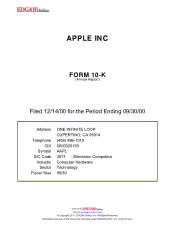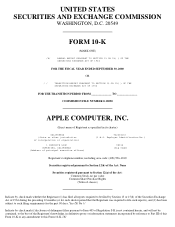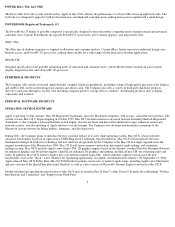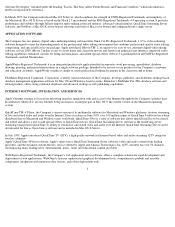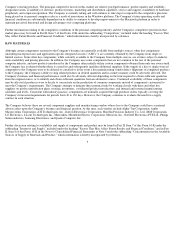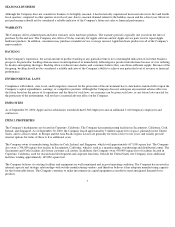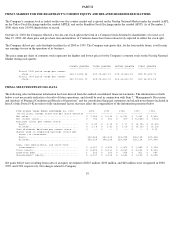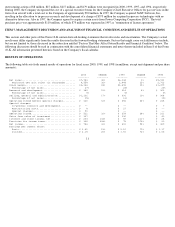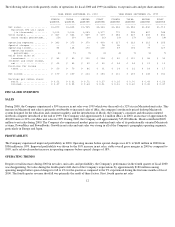Apple 2000 Annual Report Download - page 5
Download and view the complete annual report
Please find page 5 of the 2000 Apple annual report below. You can navigate through the pages in the report by either clicking on the pages listed below, or by using the keyword search tool below to find specific information within the annual report.POWER MAC-TM- G4 CUBE
The Power Mac G4 Cube system, introduced by Apple in July 2000, delivers the performance of a Power Mac G4 in an eight-inch cube. The
G4 Cube was designed to appeal to both professional users and high-end consumer users seeking more power coupled with a small design.
POWERBOOK-Registered Trademark- G3
The PowerBook G3 family of portable computers is specifically designed to meet the mobile computing needs of professionals and advanced
consumer users. Current PowerBooks incorporate PowerPC G3 processors, active-matrix displays, and long battery lives.
iMAC-TM-
The iMac line of desktop computers is targeted at education and consumer markets. Current iMacs feature innovative industrial design, easy
Internet access, and PowerPC G3 processors, making them suitable for a wide range of education and consumer applications.
iBOOK-TM-
Designed specifically for the portable computing needs of education and consumer users, current iBook features include an active-matrix
display, long battery life, and a PowerPC G3 processor.
PERIPHERAL PRODUCTS
The Company sells certain associated Apple-branded computer hardware peripherals, including a range of high quality precision color displays
and AirPort-TM- wireless networking base stations and add-in cards. The Company also sells a variety of third-party hardware products
directly to end users through its on-line store including computer printers, storage devices, memory, and imaging products such as digital
camcorders and scanners.
PRINCIPAL SOFTWARE PRODUCTS
OPERATING SYSTEM SOFTWARE
Apple's operating system software, Mac OS-Registered Trademark-
, provides Macintosh computers with an easy, consistent user interface. The
current version, Mac OS 9, began shipping in October 1999. Mac OS 9 includes numerous advanced features including Sherlock-Registered
Trademark- 2, the Company's advanced Internet search engine, features for faster and more efficient Internet usage, enhanced system and
network security, and auto updating of Apple software over the Internet. The Company also develops and distributes extensions to the
Macintosh system software including utilities, languages, and developer tools.
During 2001, the Company plans to introduce the first customer release of its new client operating system, Mac OS X, which will offer
advanced functionality based on an open-source UNIX-Registered Trademark--based foundation. Mac OS X will incorporate the most
fundamental changes in both core technology and user interface design made by the Company to the Mac OS in a single upgrade since the
original introduction of the Macintosh in 1984. Mac OS X will feature memory protection, pre-emptive multi-tasking, and symmetric
multiprocessing. Mac OS X includes Apple's new Quartz-TM- 2D graphics engine (based on the Internet-
standard Portable Document Format)
for enhanced graphics and broad font support, OpenGL for enhanced 3D graphics and gaming, and QuickTime-TM- for streaming audio and
video. In addition, Mac OS X features Apple's new user interface named Aqua-TM-, which combines superior ease-of-use with new
functionality such as the "Dock," a new interface for organizing applications, documents and miniaturized windows. On September 13, 2000,
Apple released Mac OS X Public Beta. Mac OS X Public Beta includes certain new or updated applications, including Apple's new Mail client
and new versions of the QuickTime player and Sherlock, as well as a beta version of Microsoft's Internet Explorer written for Mac OS X.
Further information regarding the introduction of Mac OS X may be found in Part II, Item 7 of this Form 10-K under the subheadings "Product
Introductions and Transitions" and "Support from Third-Party
2

